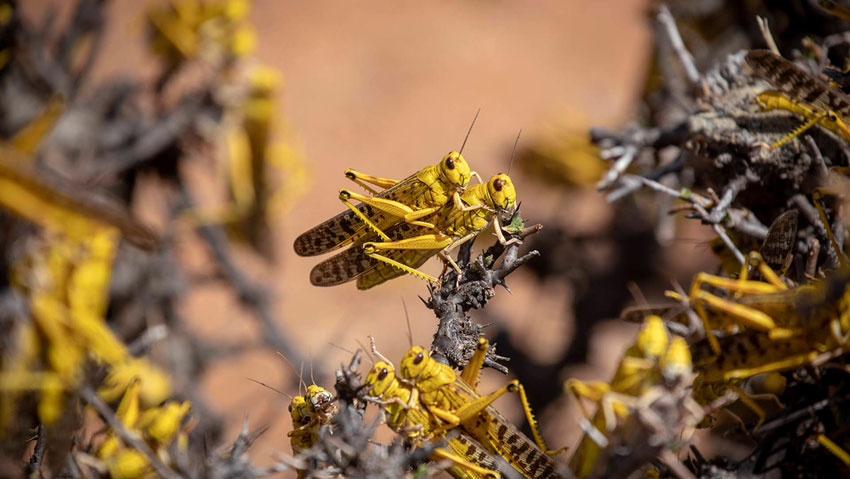Swarms of deadly desert locusts entered Uganda on Sunday after having ravaged several parts of Kenya, causing food shortages.
Locust plagues occur intermittently in the Horn of Africa, but this invasion is the worst in 25 years, according to the UN Food and Agriculture Organization (FAO). Originating at the India-Pakistan border, the locusts migrated into Somalia and Ethiopia and destroyed nearly 71,000 hectares of farmland in the two countries.
The UN has warned of a “significant and extremely dangerous” escalation in the number of desert locusts descending on the region. The FAO said the locusts can live for up to five months, depending on the weather and local conditions. They can lay eggs that hatch after two weeks, with the locusts maturing to adulthood in two to four months on average.
The Prime Minister Ruhakana Rugunda said on Sunday that pesticides have been secured and spray planes will be used to exterminate the locusts and the expectation is that the situation will be contained.
John Martin Owor, commissioner in the Department of Relief, Disaster Preparedness and Management of the Uganda Office of the Prime Minister, said the locusts entered Uganda via northwest Pokot district in Kenya, where they had destroyed hundreds of acres of vegetation and have started destroying vegetation in Uganda.
He said two air spray planes have been hired and a team of Uganda Wildlife Authority wardens will assist officials from the Ministry of Agriculture in spraying the locusts.
Facts about locusts:
1. Locusts are related to grasshoppers and the two insects look similar. However, locust behavior can be something else entirely. Locusts are sometimes solitary insects with lifestyles much like grasshoppers. But locusts have another behavioral phase called the gregarious phase. When environmental conditions produce many green plants and promote breeding, locusts can congregate into thick, mobile, ravenous swarms.
2. Locust swarms devastate crops and cause major agricultural damage and attendant human misery—famine and starvation. They occur in many parts of the world, but today locusts are most destructive in sustenance farming regions of Africa.
3. The desert locust (Schistocerca gregaria) is notorious. Found in Africa, the Middle East, and Asia, they inhabit some 60 countries and can cover one-fifth of Earth’s land surface. Desert locust plagues may threaten the economic livelihood of one-tenth of the world’s humans.
4. A desert locust swarm can be 460 square miles in size and pack between 40 and 80 million locusts into less than half a square mile.
5. Each locust can eat its weight in plants each day, so a swarm of such size would eat 423 million pounds of plants every day.
6. Like the individual animals within them, locust swarms are typically in motion and can cover vast distances. In 1954, a swarm flew from northwest Africa to Great Britain. In 1988, another made the lengthy trek from West Africa to the Caribbean.
7. In a day, a swarm of desert locusts can travel a distance of five to 130 kilometres or more at an average speed of 17kph.
8.A desert locust lives for three to five months although FAO notes that it varies depending on the environment.
They have a three-stage life cycle; egg, hopper and adult.
9.There has never been a case of human beings being attacked by locusts or the insects causing physical harm to people. Locusts, therefore, do not attack people or animals.
However, locusts have been categorised as allergen insects, meaning their activities can cause an allergic reaction to the body mainly for the asthmatic.
10. Desert locusts are mainly controlled through spraying of chemicals which can be done on the ground or aerial spraying. Hand-held sprayers may also be used but in rare cases. Another way of controlling the insects is by harvesting them for eating. Locusts are rich in protein and can be fried, roasted, boiled and eaten. Some people can eat them raw or simply dry them before consumption.
Do you have a story in your community or an opinion to share with us: Email us at Submit an Article








